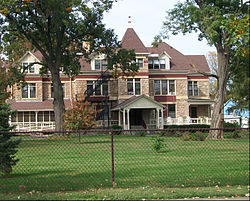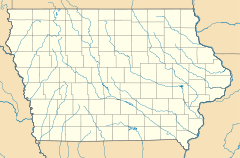- Clarissa Cook Home for the Friendless
-
Clarissa Cook Home for the Friendless

Location: 2223 W. 1st Street, Davenport, Iowa Coordinates: 41°31′9″N 90°36′37″W / 41.51917°N 90.61028°WCoordinates: 41°31′9″N 90°36′37″W / 41.51917°N 90.61028°W Built: 1884 Architect: E.C. Gardner, A.N. Carpenter Architectural style: Late Victorian Governing body: Private MPS: Davenport MRA NRHP Reference#: 83002414[1] Added to NRHP: July 7, 1983 Clarissa Cook Home for the Friendless is located at 2223 W. 1st Street, Davenport, Iowa, United States. It is listed on the National Register of Historic Places.
Contents
Ebenezer and Clarissa Cook
Ebenezer Cook was born February 14, 1810 in Oneida County, New York to Ira and Rachel (Faxon) Cook. His younger brother was John Parsons Cook, and the two worked together their whole lives. Ebenezer bought 1,200 acres (4.9 km2) of land in 1835 that would in time become part of the city of Davenport, and moved there with his extended family in 1836. He and his brother entered the legal profession and helped establish Scott County in what was then the Wisconsin Territory. They were joined in their law practice with John Forrest Dillon, who later became judge of the United States Circuit Court for the Eighth Circuit. The brothers became involved in banking and set up a chain of private banks across Iowa and Western Illinois until the country-wide panic which began in 1857. In 1851 the brothers were influential in routing the railroad through Davenport. Ebenezer became a director and then vice president of the Mississippi and Missouri Railroad when it was organized in 1853, and upon its subsequent consolidation became a director and later vice president of the Chicago, Rock Island and Pacific Railway. Ebenezer Cook died October 7, 1871.[2]
Clarissa C. (Bryan) Cook was born August 4, 1811 in Sydney, Delaware County, New York and died February 19, 1879. She was a daughter of Fowler P. and Lucretia Bryan. She was known for carrying out the wishes of her husband and their philanthropy to the City of Davenport and the Episcopal Church. Through her generosity, both during her life and after her death, she was instrumental in building Trinity Church, the Cook Memorial Library, the Clarissa Cook Home for the Friendless and the establishment of a number of trusts for the benefit of the Episcopal parishes and activities in the Diocese of Iowa and elsewhere.[2][3]
Clarissa C. Cook Home for the Friendless
The Clarissa C. Cook Home for the Friendless was founded in 1882 in the West End of Davenport. A bequest of $50,000 from the Cook’s estate made the home possible.[4] Clarissa Cook’s will outlined that the home was for “destitute and indigent females” who were over 60 years of age. They paid an entry fee of $100 and had a home and care for the rest of their lives. The facility had room to care for 25 women.[5]
In 1884 the Rt. Rev. William Stevens Perry proposed a goal to the Diocesan Convention that the Diocese of Iowa undertake a greater role in social ministry. The inspiration was the Social Gospel Movement that was popular at the time.[6] The Clarissa C. Cook Home became part of the mission of the diocese to carry out this goal. The home continues today with a more general philosophy of housing elderly women without reference to their economic situation. The name of the facility has been shortened to the Clarissa C. Cook Home.[7]
References
- ^ "National Register Information System". National Register of Historic Places. National Park Service. 2009-09-17. http://nrhp.focus.nps.gov/natreg/docs/All_Data.html.
- ^ a b Harlan, Edgar Rubey. "Cook Family". Scott County Iowa USGenWeb Project. http://iagenweb.org/boards/scott/biographies/index.cgi?read=167077. Retrieved 2010-09-17.
- ^ Roba, William (1982). Joined by a River: Quad Cities. Davenport: Lee Enterprises. p. 77.
- ^ "Clarissa C. Cook: A Legacy Of Compassion". Genesis Health System. http://www.genesishealth.com/news/2005/cook.aspx. Retrieved 2010-09-17.
- ^ Svendsen, Marls A., Bowers, Martha H (1982). Davenport where the Mississippi runs west: A Survey of Davenport History & Architecture. Davenport, Iowa: City of Davenport. pp. 14–6.
- ^ Horton, Loren N. (2003). The Beautiful Heritage: A History of the Diocese of Iowa. Des Moines: Diocese of Iowa. p. 56.
- ^ Willard, John. "Renewed Spirit". Quad-City Times (December 25, 2006). http://qctimes.com/lifestyles/article_86227232-c9f5-5d34-bb0a-7ccb3a63dff6.html. Retrieved 2010-11-17.
External links
U.S. National Register of Historic Places Topics Lists by states Alabama • Alaska • Arizona • Arkansas • California • Colorado • Connecticut • Delaware • Florida • Georgia • Hawaii • Idaho • Illinois • Indiana • Iowa • Kansas • Kentucky • Louisiana • Maine • Maryland • Massachusetts • Michigan • Minnesota • Mississippi • Missouri • Montana • Nebraska • Nevada • New Hampshire • New Jersey • New Mexico • New York • North Carolina • North Dakota • Ohio • Oklahoma • Oregon • Pennsylvania • Rhode Island • South Carolina • South Dakota • Tennessee • Texas • Utah • Vermont • Virginia • Washington • West Virginia • Wisconsin • WyomingLists by territories Lists by associated states Other  Category:National Register of Historic Places •
Category:National Register of Historic Places •  Portal:National Register of Historic Places
Portal:National Register of Historic PlacesDavenport, Iowa City and Government History | Neighborhoods | National Register of Historic Places: Downtown, East, West | City Hall | Scott County Court House | U.S. Court House
Landmarks Education Transportation Neighborhoods College Square | Cork Hill | Crescent Warehouse | Hamburg | McClellan Heights | Prospect Park | Riverview Terrace | Vander Veer Park | West Third Street
Other Bix 7 | Credit Island | Lock and Dam No. 15 | Vander Veer Park | African Americans
Quad Cities and surrounding metropolitan area of Iowa and Illinois Iowa Illinois - Henry County
- Mercer County
- Rock Island County
- Rock Island
- Moline
- East Moline
- Aledo
- Annawan
- Andalusia
- Barstow
- Bishop Hill
- Buffalo Prairie
- Cambridge
- Carbon Cliff
- Cleveland
- Coal Valley
- Colona
- Coyne Center
- Dayton
- Edgington
- Galva
- Geneseo
- Green River
- Hampton
- Hillsdale
- Hooppole
- Kewanee
- Illinois City
- Milan
- Nekoma
- Oak Grove
- Orion
- Ophiem
- Osco
- Port Byron
- Reylonds
- Swedona
- Silvis
- Woodhull
Attractions Colleges Historical Places Categories:- Buildings and structures completed in 1884
- Victorian architecture in Iowa
- Residential buildings on the National Register of Historic Places in Iowa
- Davenport, Iowa National Register of Historic Places Multiple Property Submissions
- Buildings and structures in Davenport, Iowa
- National Register of Historic Places in Scott County, Iowa
Wikimedia Foundation. 2010.

